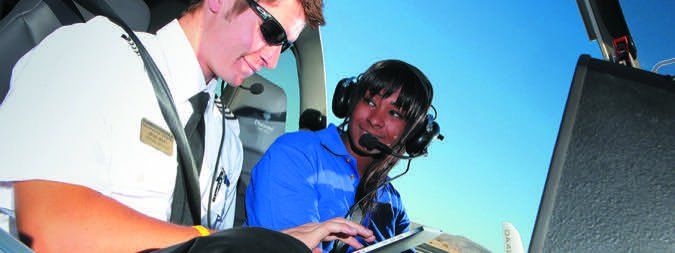We’ve been following the debate over the existence of a pilot shortage with some interest. We think that one piece of evidence has shoved the needle to the “Yep, there is one” side of the scale so definitively that the debate is over: Flight schools are actively recruiting flight instructors and paying them a living wage. In some cases flight schools are also offering hiring bonuses.
Because the jobs new commercially rated pilots traditionally got to build time so they could eventually get hired by the airlines—night freight and check hauling—have dried up, currently the most popular way for low-time pilots to build time is to flight instruct. That being the case, we decided to take a fresh look at what is involved in obtaining the flight instructor rating—primarily time and cost factors.
We’ll start by referencing a conversation we had with the chief flight instructor, Manpreet “Prince” Singh, at the CFI Academy (www.cfiacademy.com) in Lodi, California, the only flight school we know of that focuses exclusively on training CFIs. Singh pointed out that getting the CFI rating will be an experience unlike obtaining any rating the pilot already has. For the first time the pilot will not merely be facing a completion standard of demonstrating “satisfactory knowledge” of a task or flight operation—he or she will be required to demonstrate what the FAA refers to as “instructional knowledge” of that task or flight operation. To become an instructor a pilot must know the why or how of a flight operation, not just have enough understanding to get by.
Singh went on to say that for a pilot to pass the CFI practical exam she or he will have to know the material and be able to explain it clearly at a very basic level and be able to demonstrate the ability to modify his or her teaching method to meet the learning method of the individual student. Good communication skills are a must.
We agree with Singh’s observations and recommend to any pilot who is seeking to become a CFI that he or she understand going in that it will be hard work, the vast majority of the time spent will be on the ground—because she or he should already know how to fly—and that there are no shortcuts to the rating. The FAA considers flight instructors as its conduits to general aviation pilots—current and to be—and therefore demands a great deal of those who want to become instructors. That is reflected in a far higher first-time failure rate for the CFI practical test—we were told that it was as high as 70 percent in some areas.
There are three CFI ratings for airplanes—airplane single-engine, airplane multi-engine and instrument airplane—and to keep this article to a reasonable length, it’s limited to airplane CFI ratings. One of the conclusions we reached while researching this article was that if at all possible from a time and finances position, if a person wants to get more than one of the airplane CFI ratings (pilots almost invariably obtain the CFI airplane single-engine first), to do them one after another, especially airplane single-engine and then instrument airplane. Once you’ve gotten up to speed to pass one practical exam it’s far easier to get ready for the others right away.
The Written Exams
Photo: Embry Riddle Aeronautical University.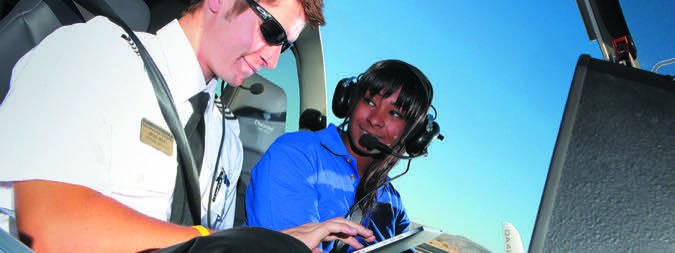
There are three FAA written examinations applicable to the various flight instructor airplane ratings. The first is Fundamentals of Instruction (FOI), which must be successfully completed by anyone seeking any of the CFI airplane ratings unless the pilot meets one of the requirements set out in 61.185(b) to be exempted from completing the test—by already holding a flight or ground instructor certificate or being a teacher or college professor at the level set out in the reg. The second is Flight Instructor Airplane (FIA). The third is Flight Instructor Instrument Airplane (FIIA).
A person seeking a CFI Airplane rating must pass the FOI and FIA exams. To then become an instrument instructor the applicant has to pass the FIIA exam. To add on the multi-engine flight instructor rating to an existing flight instructor airplane rating, the applicant does not have to take a written examination.
Study Materials
We weren’t kidding about the hard work involved with obtaining a flight instructor rating—and it starts with the volume of material a pilot has to master. At the most basic level, an applicant must be familiar with all the references in the Flight Instructor Practical Test Standards (PTS)—soon to be Airman Certification Standards (ACS)—and those in the Private Pilot ACS, Commercial Pilot PTS and, if going to become an instrument instructor, Instrument Rating ACS.
The good news is that all of the references are FAA publications and are available free on www.faa.gov. They include The Airplane Flying Handbook, Pilot’s Handbook of Aeronautical Knowledge, Aviation Instructors Handbook, Instrument Procedures Handbook, Aeronautical Information Manual, the Federal Aviation Regulations and the PTS/ACS for the private, commercial, instrument and flight instructor ratings.
Enterprising aeronautical publishers also sell the FAA publications in hard copy and electronic form. We found prices for the electronic books under $5 while hard copy prices ranged in the mid-teens. We also found a number of books in electronic and hard copy form written for the prospective flight instructor, enough that we cannot even try to list them in an article of a reasonable length. Our cursory review did not reveal any that were of poor quality. We do recommend one book, The Advanced Pilot’s Flight Manual, by William K. and William C. Kershner, for a prospective flight instructor because of its concise and clear explanation of aerodynamics and aeronautical concepts. We found copies available for as low as $6.
Written Test Prep
We looked at five providers of courses for the flight instructor written and/or practical tests. It is a competitive field and we liked the quality of all the materials we saw.
Sheppard Air. Sheppard Air’s test prep courses (www.sheppardair.com) are offered via downloadable software that is unabashedly designed to teach the student just what is necessary to pass the FAA written.
Studying starts with going through the questions with only the correct answer displayed. The student can click on an explanation box and get a brief explanation of the correct answer. The student is then to go through the questions again with all the answers showing while learning to recognize the correct answer.
Price for the FOI course is $30, for the FIA $40 and the FIIA is also $40. Sheppard Air has instructors on duty 24 hours a day to answer questions that come up while studying.
Gleim. We’ve long liked Gleim’s (www.gleim.com) “just the facts, Ma’am” approach to training. It offers an online ground school for the FOI for $49.95, the FIA for $99.95 and a kit that combines the two and adds several hard copy publications and a flight bag for $189.95.
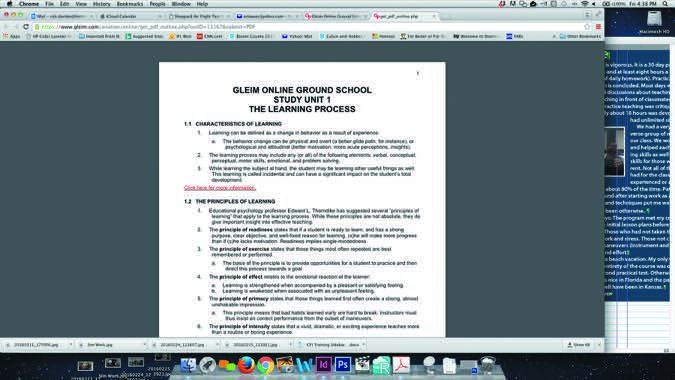
The courses are semi-structured in that the student first reads from an e-book and then takes practice quizzes. It concludes with what we consider very realistic practice tests. There are no videos. Once in the question bank, in study mode, the student can call up all or some of the questions for a particular topic. Clicking on an answer provides instant feedback as to whether the answer is correct or not, in impressive detail. It keeps a running tab of questions missed and presents that data in a progress review section. Once the student has answered all of the required questions in the test prep correctly, he or she may request and obtain an endorsement to take the FAA knowledge test.
Dauntless. For more than 15 years Dauntless (www.dauntless-soft.com) has offered “active learning by doing” and “learning by simulated testing” downloadable software for FAA computerized knowledge test preparation courses. The student selects one of the knowledge areas within the particular test prep and starts with “test/study” mode. It introduces the student to the material with FAA-style test questions, the correct answer and an extensive explanation, often with high-quality graphics.
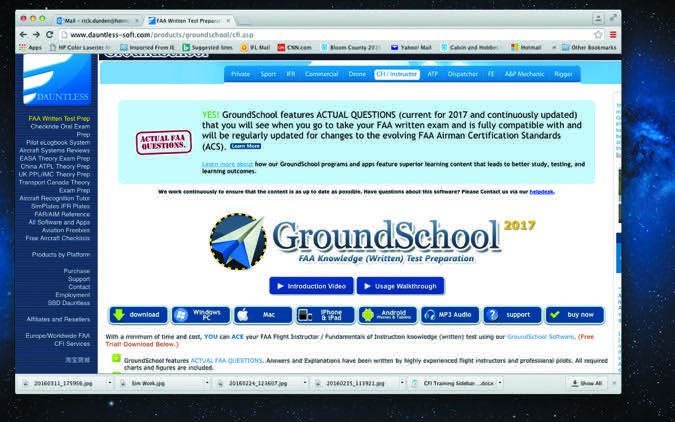
The student then repeats the knowledge area in “learning and practice” mode, answering questions and getting immediate feedback. Finally the student takes FAA-style tests that simulate the real thing. Dauntless advertises that, like the FAA, it discourages rote memorization and encourages understanding of knowledge areas; however, it also advertises that it provides just the materials to learn what is necessary to pass the knowledge test and nothing more.
Dauntless test preps for the FOI, FIA and FIIA are $49.99 for new users ($44.99 for returning customers) and they will bundle any three test banks for $104.99.
King Schools. Long a heavyweight in the pilot training video world, Martha and John King (www.kingschools.com) advertise, and our observation of their courses confirms, that their courses seek to help turn out well-rounded pilots who understand and can teach the concepts involved in aviation.
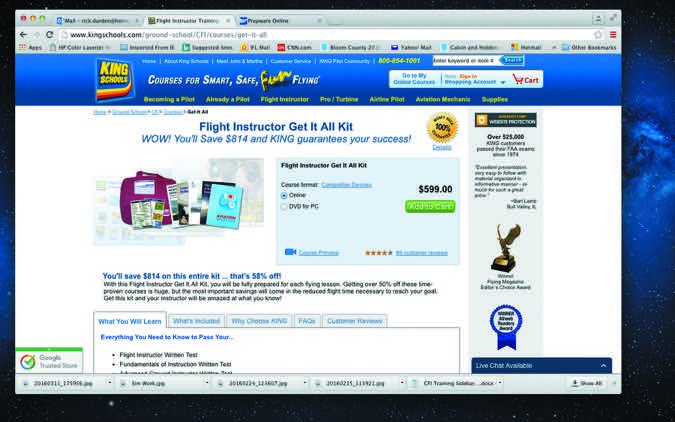
The courses are organized into a recommended flow through the major subject areas with them broken into digestible bits. Review questions then appear with immediate feedback and a report card of success on the questions is generated.
King packages its video courses in a number of ways, from the FIA/FOI ground school and test prep for $279 through a “Flight Instructor Get It All Kit” for the FOI, FIA, advanced ground instructor written and CFI checkride oral and written prep as we’ll as a number of hard copy publications for $599.
ASA. Known for its high-quality aviation textbooks and test prep books, ASA (www.asa2fly.com) offers its Virtual Test Prep series and Prepware designed to prepare the student to take the FOI and FIA knowledge exams. The Virtual Test Prep consists of a number of videos—we counted 10, priced at $9.95 each, on specific knowledge areas. They can be purchased as a bundle for $79.95.

ASA’s Prepware series is offered on multiple platforms for the FOI and FIA written exams at $49.95 each. We consider ASA’s CFI materials to be test prep rather than ground school for the CFI rating. As test prep, they live up to ASA’s usual high standards with high-quality graphics and explanation of answers.
The Practical Exam
As we said, the majority of the work a pilot goes through to get ready for the CFI practical exam is done on the ground. That should include practice teaching in a classroom environment and one-on-one. The flying portion generally consists of getting used to flying from the right seat while learning to teach while demonstrating the maneuvers. We were told by a number of sources that a pilot who has the maneuvers down cold from the left seat can make the transition in 10 hours.
From our informal survey, it appears that more CFI candidates currently go a formal program at one of the larger flight schools as opposed to flying with a local flight school. We were told by Kathryn Robine, an instructor with the Michigan Flyers in Ann Arbor, Michigan, that a primary reason for not getting the rating locally is a scarcity of complex airplanes—which are required for the practical test—to rent. She had to go to four FBOs before she could find a suitable complex airplane for her most recent CFI student to fly—two airplanes had serious mechanical problems requiring extended downtime and one was in such lousy shape she wouldn’t dare send the student for a checkride.
Nevertheless, Ed Pataky, a new instructor in the Houston area, told us he kept the cost of the rating down by working with an instructor he respected and reading everything he could get his hands on to make sure he had the broadest possible knowledge base. Pataky did as much of his training, including spins, in a Cessna 150, and only finishing up and taking the test in a Cherokee Arrow.
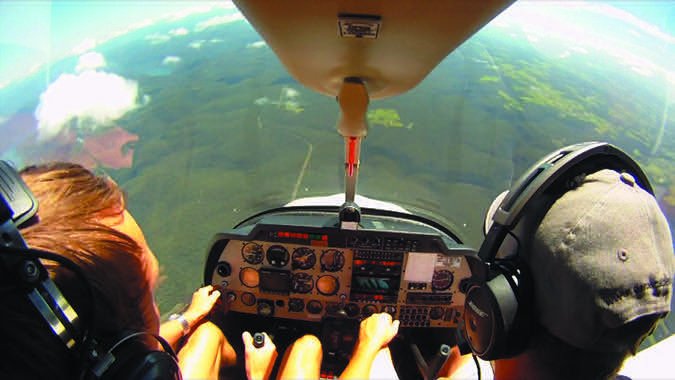
Formal Programs
Because of the high failure rate for initial CFI practical tests, we recommend going through some form of formal CFI training program that includes extensive ground training and critiqued classroom instruction time. Such programs, in our opinion, are geared to successfully turning out well-rounded CFIs. We also think formal programs help fight one of the dirty secrets in the industry—the FAA has drastically reduced the number of Designated Pilot Examiners (DPEs), so there can be delays of up to three months in getting a checkride scheduled and because of the reduced number of DPEs, they get away with charging $700 to $900 for a CFI checkride. We heard of rates as high as $1500—highway robbery, in our opinion. The FAA is supposed to give initial CFI checkrides (it’s free when an FAA inspector gives the ride), but farms most out to DPEs. Major flight schools seem to be able to schedule checkrides more efficiently than local instructors because they are sending out a steady stream of applicants.
Our survey of flight schools revealed that for the CFI airplane rating most offered 40 to 60 hours of ground instruction and up to 10 hours of dual in a complex aircraft. Most were intensive 15-day programs at the flight school, which means the student pays for lodging (we saw everything from tent camping to expensive motels offered). We saw prices from $3195 to $5000, which did not include the DPE fee. We did see some five- and seven-day programs but did not consider them to include adequate ground training time to prepare a student for the practical exam.
A number of schools offered instrument flight instructor training as an adjunct to the airplane instructor training for a surprisingly modest additional fee and another 15 days of time. For example, American Flyers (www.americanflyers.net) charges $3195 for its 15-day course for the CFI-A and $3,995 for its 30-day CFI-A and CFI-I combination course.
Of the schools we surveyed, most required that the incoming student have successfully completed the appropriate FAA knowledge tests and have the spin endorsement. Some of the schools offered extra instruction for those students who had not completed such prerequisites.
New instructor J. Scott Dyer completed the 30-day American Flyers course for his airplane and instrument CFI (sidebar page 17). He was emphatic that if he had not arrived current and comfortable on instruments and with the private and commercial maneuvers, it would have been difficult to complete the class in the time allotted.
A New CFI
Prince Singh of the CFI Academy told us that he gets two to three calls a week from flight schools seeking CFI graduates to come work for them but that some 90 percent of the students who come through his program already have jobs lined up.
Even a cursory internet search reveals several training programs that are seeking flight instructors with signing bonuses and an annual income as high as $35,000, although we still take such claims with a certain grain of salt.
New instructors who were working part time for local flight schools and FBOs reported being paid between $20 and $40 per hour (for flight or ground instruction).
We did speak with instructors who were hired by commuter airlines upon hitting the magic 1500 hour mark, making it an excellent stepping stone to an airline or corporate career. Finally, we also spoke with instructors who were coming into professional aviation as a part-time, second or even retirement career and found that they enjoyed it so much that they were going to going to stick with it for the foreseeable future.
One Pilot’s CFI Training Experience At American Flyers
I took the knowledge tests for CFI/I 15 or 20 years ago but then didn’t follow through with the rest of the training. I was in a busy law practice that required 24/7 availability on short notice, and the bulk of initial CFI candidates failed their practical tests reputedly as a way of building character. Nobody has time for that. I put the CFI idea on hold with the Advanced Ground and Instrument Ground Instructor certificates as consolation prizes.
I knew I wanted to instruct part-time as I approached retirement at the end of 2015. I did some research and developed two principal criteria in looking for concentrated training: I wanted a program that would maximize my chances of avoiding the quasi-obligatory first-time fail, and I wanted substantial practice teaching experience in a group setting. The training location had to have almost guaranteed flyable weather.
There are a number of choices for CFI training around the country. The larger programs seemed to better satisfy my criteria. I heard some good things about American Flyers in Pompano Beach, Florida, and in particular the head instructor in that program, Patrick Connell (photo above). He had been teaching instructors for decades with a strong track record.
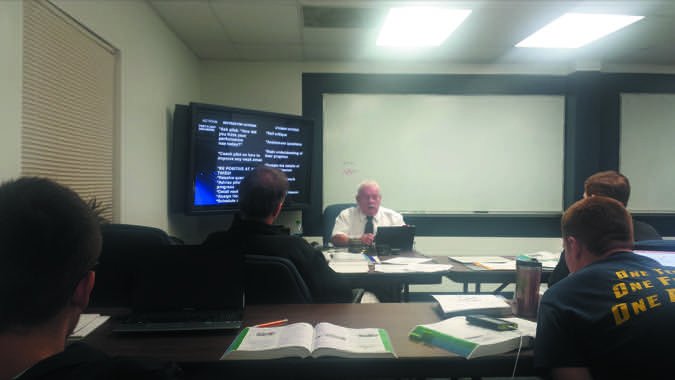
I signed up for a February 2016 CFI airplane and instrument class cycle in Pompano. In preparation for class, I took the knowledge tests. I spent roughly eight hours every day for six weeks before class studying and drafting plans for private, commercial and instrument lessons. I flew with a local instructor to hone the commercial maneuvers that I hadn’t practiced recently.
The pace is vigorous. It is a 30-day program, seven days a week and at least eight hours a day (plus two to four hours of daily homework). Practical tests come after the program is concluded. Most days were split between lectures and discussions about teaching techniques, and practice teaching in front of classmates. At least once a week, our practice teaching was critiqued in detail by Connell. Only about 10 hours was devoted to flying. We had unlimited sim (BATD) time.
We had a very cohesive and diverse group of motivated people in our class. We worked hard together and helped each other with teaching skills as we’ll as instrument skills for those who were not current. Not all of the instructors we had for the class training were as experienced or effective as Patrick, who taught about 80 percent of the time. Patrick is a superb teacher; I found after starting work as an instructor that his training and techniques put me way ahead of where I would have been otherwise.
Takeaways: The program met my criteria. Those who hadn’t done initial lesson plans before class had to work extra hard. Those who had not taken the knowledge tests had extra work and stress. Those not current in flying the necessary maneuvers (instrument and visual) needed extra time and effort.
This isn’t a beach vacation. My only visit to the beach during the entirety of the course was on the afternoon after my second practical test. Otherwise, while the weather was nice in Florida and the palm trees attractive, I might as we’ll have been in Kansas.
—J. Scott Dyer

